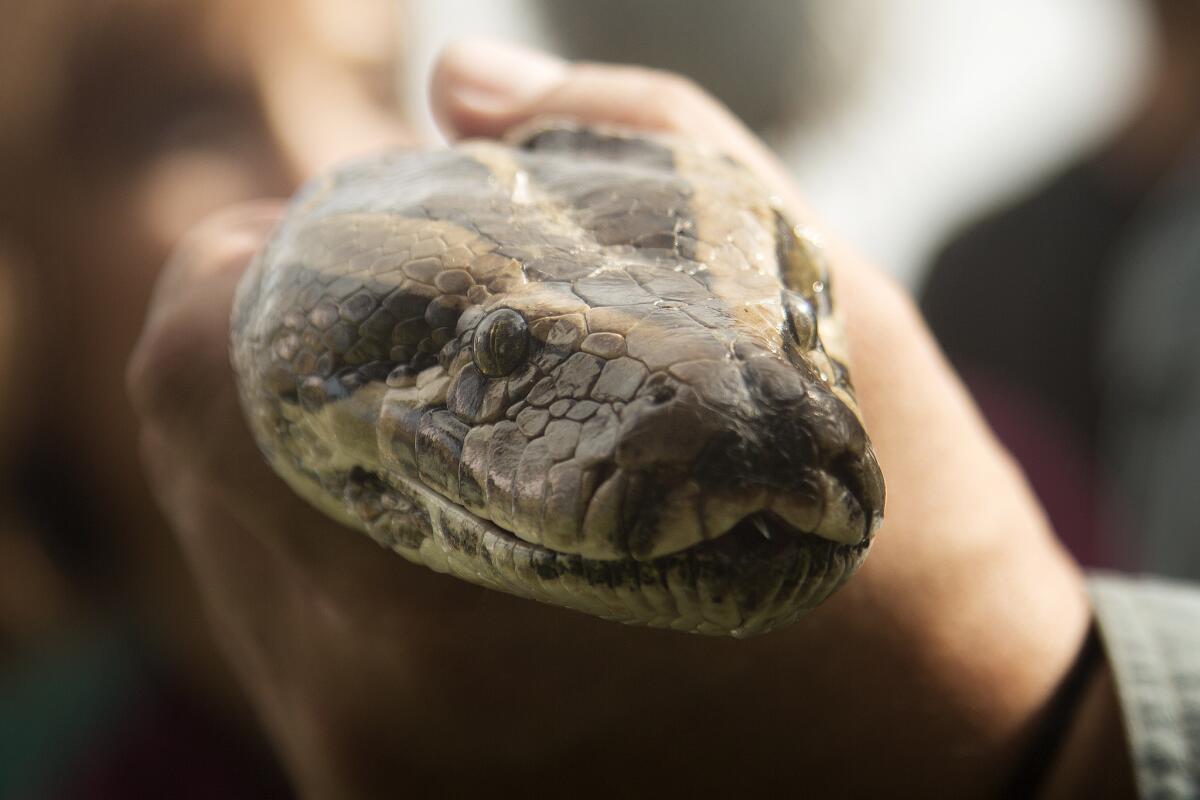Florida’s python problem: Snakes are decimating mammals in the Everglades

- Share via
Florida has a python problem, and it may be worse than anyone thought.
In a new study, researchers found that the voracious appetite of the Burmese python can outpace even the reproductive speed of the marsh rabbit, a small brown bunny that seems to have disappeared from the Everglades National Park.
“The Everglades National Park is a massive place so I can’t say the rabbits are gone entirely, but we can’t find any of them, and we’re pretty good at looking,” said Robert McCleery, a professor of wildlife ecology at the University of Florida in Gainesville who led the study.
The disappearance of the marsh rabbit is particularly distressing because rabbits multiply quickly. According to the paper, the marsh rabbit can produce up to six litters of three to five young a year.
“We specifically chose the marsh rabbits to study because it’s a critter that breeds all the time, and you shouldn’t be able to eat enough of it to wipe it out,” McCleery said.
Researchers had already noticed that the precipitous drop in mammal populations coincided with the rise of invasive pythons in the Florida Everglades. While it seemed likely that the pythons were responsible for the loss of mammal life in the park, researchers didn’t have any hard data to back that hypothesis up.
So, McCleery and his team devised a way to track what percentage of mammal deaths in the park were due to pythons.
In September of 2012 they captured 95 marsh rabbits from nearby areas and put radio tags on them. Some of the tagged bunnies were released into the python-infested park, and others were released into a nearby wildlife refuge that had remained python free.
Over the next nine months, they followed the rabbits’ deaths, noting whether they had been eaten by birds of prey, other mammals, pythons or other reptiles.
Fifteen rabbits died within the first 10 days of the study, but the researchers considered this time a transitional period while the rabbits got used to their new environment.
An additional 10 rabbits were lost over the course of the study, probably because of faulty equipment, and two rabbits were alive at the end of the study, nine months later. That left 68 total bunny deaths that the scientists could include in their data set.
In the confines of the park, they found that 77% of all bunny deaths were due to pythons, and only one death was due to predation by a mammal. Outside the park there were no python deaths, and 71% of the bunny deaths were caused by mammals like coyotes and bobcats.
The results were published Tuesday in the journal Proceedings of the Royal Society B.
It should also be noted that the bunnies that had been released in the park were not all gobbled up by hungry pythons right away.
The researchers write that in February of 2013, five months after the release of the marsh rabbits, they were finding evidence of baby rabbits in the park, suggesting that they had already established reproductive populations. However, as the temperature grew warmer, the ectothermic pythons, whose body temperatures are regulated by external sources, became more active.
“There was a drastic shift,” McCleery said. “Our population was reproducing, but then it got hot and wet, and all of a sudden they disappeared. We were shocked.”
Burmese pythons had been spotted sporadically in the Everglades National Park since the 1980s. However, it wasn’t until the early 2000s that scientists first found baby pythons in the park, suggesting the giant snakes had become established.
McCleery said his study provides solid evidence that these invasive pythons are capable of decimating mammal populations in the park. Now, he hopes there will be renewed interest in getting the pythons out.
It won’t be easy. Pythons can hide in water with just the tip of their nose at the surface to breathe, rendering them almost invisible. They are good at camouflaging on the ground as well. And because they are ambush predators, they don’t move around a lot.
But McCleery hasn’t given up hope yet.
“A lot of really smart people have been trying to figure out how to solve this problem and there are still plenty of things we can try,” he said. “We are not done yet.”
Science rules! Follow me @DeborahNetburn and “like” Los Angeles Times Science & Health on Facebook.







